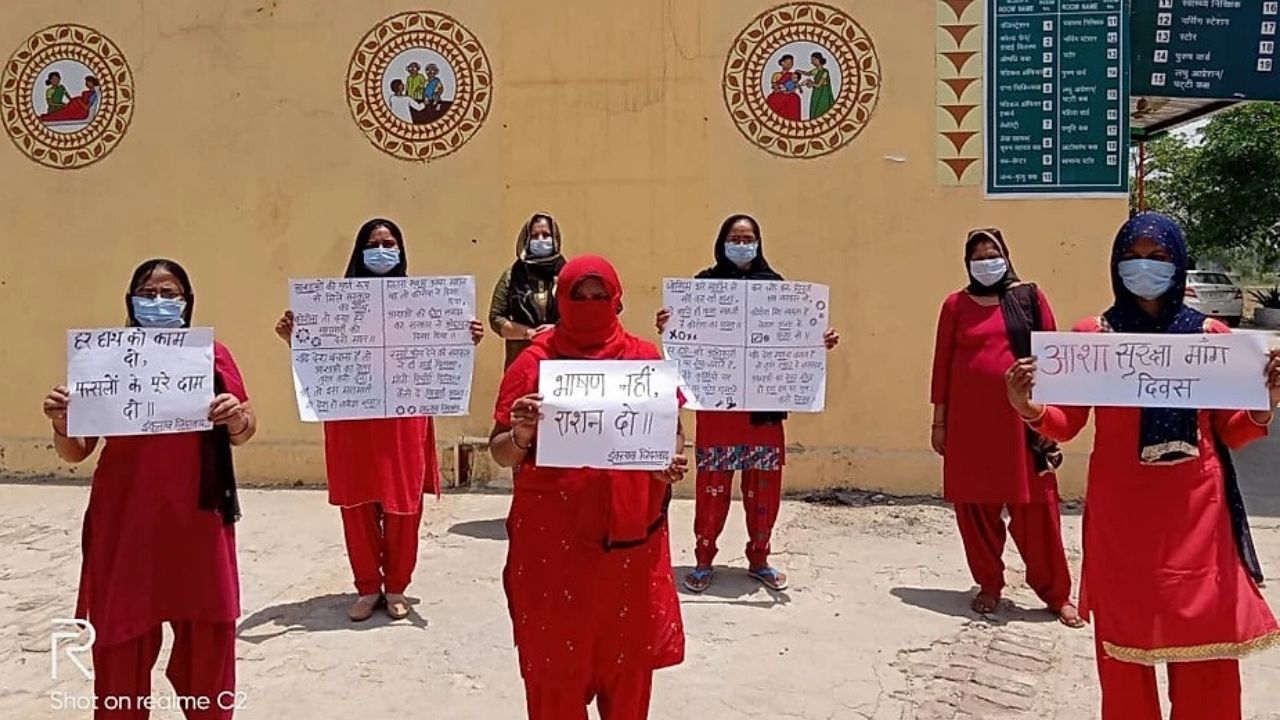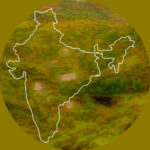Visualizing
the Virus
Journalism with a Gender Lens
BehanBox

ASHAs in Haryana protest for better pay & testing facilities during the Covid pandemic./HARYANA ASHA WORKERS UNION
In this video interview (transcribed below), Faiza Masoodis in conversation with public policy researcher and journalist Bhanupriya Rao, founder of the BehanBox project, an online publication from India which aims to bring the voices of women and gender diverse persons to the center of public discourse. BehanBox sheds light on existing and widening gender gaps with a critical look at the law, policy and data.
In this interview, Bhanupriya shares how the BehanBox project started and how the pandemic has rendered experiences of inequity visible, such as the realities of women migrant workers, ASHA front line workers, and the inadequate state of education for young girls in rural and deprived communities. Bhanupriya also elaborates on the impact her project has had so far, including bringing these stories to the Indian public via social media and also to the Indian state, with the hope that this newfound visibility will lead to long-term structural change.
Transcript
Faiza Masood 0:03
Okay, so we’re here today with Bhanupriya Rao, the founder of BehanBox, which started in 2020. And I am Faiza Masood a part of the Visualizing the Virus project. Today we’re going to be talking with Bhanu about her projects. So just to start up, Bhanu. Would you like to introduce yourself and your project?
Bhanupriya 0:33
Oh, yes, absolutely. Hi. Faiza. Thank you so much for having this chat with me. So I am Bhanupriya, I am the founder of BehanBox, which is a digital media platform, slash publication, focusing entirely on women and girls and gender diverse persons in India. So we look at, we look at the lives of women, and gender diverse persons with, with a focus on the lived experiences, law, policy and data. And, and we are a pan-India sort of a platform. So we do stories from across India, and from the remotest parts of India, just to tell the stories of women, which go unreported, and unspoken of as well. So that’s our mission, really.
Faiza Masood 1:30
That’s great–And what inspired you to start BehanBox, and what did you hope to achieve with it?
Bhanupriya 1:37
So first of all, I used to be a public policy researcher, and I used to work with a grassroots organizations in India. And, you know, as someone who’s worked, there, it was pretty apparent to, you know, it was very visible, the sort of inequality that exists in India, and especially the gender inequality, when it kind of merges with intersects with other forms of inequality, like income, inequality, caste, inequality, and all of that, so. And as a reporter, when I became a journalist, few years ago, I also realized, you know, how much these stories needed to be told. And, how for us, what was really apparent, both, as someone who’s an public policy researcher and a journalist, is that everything is an issue of governance, you know, so governance and state play a big part in people’s lives, and therefore, any inequality that manifests is really a problem of state structures, societal structures, and so on. And as a journalist, it was pretty visible to me, in fact, pretty bothersome to me that these issues are not covered, and when it comes to gender, there is a particular kind of coverage of gender that happens. It is very event based, which is driven by violence and events of violence, or sexual assault, and so on. And I realized that, you know, if we had to talk about the lives and issues of the 50%, of population of any country, and particularly India, we needed a completely different project or media project to do that. That kind of reporting, where we wanted to bring these stories out. So, I’ve been thinking about that for some time, and you know how an idea keeps brewing in your head, and you keep sort of postponing it until you feel that this is the time you got to do it. And for us that time was really during the pandemic, because we knew instinctively that with the pandemic, all these existing inequalities are going to sort of manifest themselves and become even more wider. So when we talk about stories, we just don’t talk about, you know, just a story, we look at the structures around it, why something is the way it is, right? So, what we realized was all of this is again, going to be sort of steamed over or you know, is going to be invisible, really. So we wanted to put that spotlight back on how the pandemic is going to and was already having a really bad effect on women and women with multiple marginalizations, so that’s why there was an urgency with which we started off in 2020. In fact, one of our first projects that we did was an investigative project around women health care workers in India, which kind of put the spotlight national spotlight back on health care workers and and the issues they were facing and being on the front line of the pandemic, we talked about domestic violence during the pandemic, we talked about the lives of school children and young girls totally disrupted, falling out of school, you know, falling off the radar of everything, being sort of pushed into child marriages, child labor, and all these issues, which mainstream media was completely missing out. So we were kind of reporting a lot, we were putting that spotlight back on, where it needs to be really, and also in doing so we were pushing the state and society to take a deeper look into the lives of women and children. Really.
Faiza Masood 5:43
Yeah, that’s fabulous. Thank you so much for that, and thank you so much for your work and highlighting these issues that you, as you mentioned, are already existing in society, and have to do with structural inequalities. So, you know, that’s fantastic work to shed light on these stories, and how these issues have become exacerbated with the pandemic. And speaking of that, what ways do think the pandemic has actually made these issues more visible, not just through your work, but the pandemic itself? Like what ways has the pandemic made these experiences and inequity visible, in ways that they might otherwise not be?
Bhanupriya 6:40
Right, I can speak for, from a gender point of view, because that is what we look at. I mean, of course, the pandemic has had an impact on everyone. And the more marginalized you are, the more it has an an effect on you. So this argument that has been put forward, that the pandemic has really been a leveler is a wrong one, because it hasn’t been. Yes, it’s affected everyone physically, everyone who’s contracted the virus, but it, you know, the effects of it have been different on different people from different sections of the society, depending on where you will locate it socially and economically. But also, you know, it’s not just physical and health wise, it was the impact has been so much more beyond health. And this is where the sort of a person’s economic and social location comes into play. So in India’s case, the first thing that I would like to talk about where the pandemic has had a big effect, especially from a gendered point of view, and which came a lot into focus was the way our healthcare system treats the completely women, dominated workforce, called the ASHA workers (Accredited Social Health Activist Workers) who are at really at the frontline of the healthcare system in in India, they have been for the last 20 odd years. But when the pandemic happened, they were really the first ones to be called into service, they put in hours of work and without adequate protection without adequate remuneration, and so on. And once we started talking about the issues of the health care workers through their own voices, we did a project where we collected their voices, we asked them to talk about their specific issues. And, for the first time in the world, the rest of the country and the world heard that, that healthcare workers were being paid 30 to 33 rupees a day, which is which is less than $1 a day as their remuneration from the state and they did not have job security, or they did not have any benefits apart from the meager salary that they were being paid. They were not given adequate protection. They were not they were working close to 12 to 18 hours a day. And, you know, and really they were doing the most important work of contact tracing and the frontline activity of identifying people who would contracted by the virus and you know, putting them in quarantines and so on and so forth. So, and here was this whole class of workers who really kind of fought on the frontlines and yet they were just not being, you know, recognized either by the state or society and so on. So that was one of the things that came out in terms of the inequality and of how things really are, right. The other thing that came out during the pandemic, another kind of inequality was income inequality. Now, once again, what happened was, the people who were really, really affected were the migrant laborers, the people that were, you know, with, with all sorts of uncertainty, most of the labor that most of the people who live in the villages who work in cities, just didn’t know what was going on, there was poor communication. So they were all, you know, there was this migrant Exodus which the world saw, you know, which was, which was, which was brutal. And, and the whole kind of life turned upside down. And even till today, you will see the effects of that, you know, both in terms of data and from lived experiences. Now, what was not really spoken about when the migrant Exodus happened was, that migrants had a very gendered face, too. So we were, you know, and so we, when, what was not being talked about, there was all, you know, all these women who made 300, 400 kilometers long journeys by road, who were pregnant, who were, you know, working through the heat, you know, remember, it was March 2020. So, by March, it starts to get very hot in India. Right, so until today, with jobs not being returned, and, you know, you will see that the brunt of economic inequality is being borne by women, right. So, it varies, in terms of how many men and women have returned to work, I don’t have the exact statistics of my other top of my head, but it is far fewer than A) the men but also far fewer than the number of people that were in the workforce, both formal and in informal economy. At that time, we saw that once people are part of the informal economy, you know, there is no social security, no extra benefits, and so on and so forth. So it is pretty, pretty clear that, you know, that kind of brutal impact that is on women workers in the informal economy is pretty apparent. And the third and most important thing, actually, one very important thing is the rise of violence, which, you know, everybody knows there’s violence against women in every society in this world, India, particularly, so it’s not spoken about very much. It’s not reported on very much it is not a public health issue. But one thing that did come up quite a lot, and it was being spoken about quite a lot during during the pandemic was the rise, especially during the lockdown period, the rise in, in domestic violence, with people cooped up with their abusers, and, you know, the rise in domestic and intimate partner violence, those numbers went up. And people, were really beginning to hear these things which already existed in the society, except that there was some escape or some sort of let up when partners went out. So there was a lot of conversation around on domestic and intimate partner violence during the pandemic. So yeah, in terms of inequalities, they’ve kind of exacerbated massively during the pandemic, the effects of which we’ve seen even now, which is coupled with the rise of rising prices, cost of living crisis, and all of that,
Faiza Masood 13:52
Right, thank you so much for explaining that Bhanu and so articulately. So definitely seeing in all these spheres of society, whether in terms of class, economic and social class, in terms of the domestic sphere there are issues that have been highlighted with a pandemic and have come out and made more visible and apparent. And then you’ve also mentioned how they’re women workers who were the frontline workers in India, and not only were they the ones kind of taking the brunt of the pandemic, but of also the healthcare system, right. They’re also the brunt of that and that they are the frontline workers and having to hold the healthcare system and then not being compensated properly for that work, which is the most crucial work in society really, in maintaining society, especially during a pandemic. And then, you also mentioned previously that BehanBox project has not shed light on issues with women, but also young girls, in terms of education. Could you speak to that a little bit and how the pandemic also affected young girls in terms of their education?
Bhanupriya 15:21
So, you know, it’s one of the issues that is not being spoken out very much, when the pandemic happened in the early days, and even, you know, a few months down the line, especially in the last year 2021, with the second wave, the delta wave that happened, and it had a brutal effect on every one, especially in India, but, it’s almost like as if all of these are somehow in the past, but actually, the impact of those things are being felt now, it is even worse now, because, you know, people have forgotten and moved on. But for the people who live with such precarity, the impact is just being seen, and it’ll perhaps be even more, it will be quite a while before people kind of get over this thing. So girls, young girls are one of them. One of these demographics which is a not been talked about much, but also people have moved on from this education crisis. The number of girls that go to schools in India, especially at the primary level are probably at par with the boys. But as you go into secondary education, you will see a wide learning gap between them. So things were improving quite a lot, but it still wasn’t the same. And then the pandemic hit kids were forced to go online, and everyone did, okay. Now, it impacted most of the girls, girls in rural India, and semi-urban India and girls from the most marginalized communities, because what happens is that there is a big, you know, when you go online, there is a big technology gap that already exists, you know, and families were often sharing one mobile phone or smartphone, most of the very deprived families didn’t even have a smartphone, they don’t have a smartphone. That is the reality of India. But for those, even those who have a smartphone, the first priority is always the boys, right? And so the girls are naturally left out. And so the more, the poorer you are, the more marginalized you are, the less access you have so girls were naturally left out of the education system during the pandemic, and with with rising costs, and with no jobs, no family incomes and so on, girls started to become liabilities to the families. India had made a lot of progress as far as early marriages were concerned, but it wasn’t completely over. It wasn’t, it was a country that was making progress. Now, with this, what has happened is that, girls are now being put into early marriages, because families saw them as burdens, I saw them as another mouth to feed. And this is a real issue, you know, that much as brutal as it sounds that they do find girls another mouth to feed and for them, having them married off and, you know, having them become the responsibility of another family makes economic sense. And that’s what is happening. That was what was happening then. Across India, we’ve heard reports of young girls being pushed into early marriages and it continues to happen now even when things are returning to some sort of normal, are girls back in schools?– not really. Even when they what has happened is with less income to spare girls who were in private education have been either pulled out of schools or been sent to public schools, which have real quality issues especially in the most backward parts of India and in the hinterland where having quality teachers is still a problem. So if you look at it in this whole context, you see that girls have been quite impacted. And the progress that they were making in this country, all the opportunities and aspirations that girls were dreaming about, in all, you know, in the last decade or so, completely came to a knot, due to the pandemic. And so, and even when they they were having, they had some sort of access, the quality of education fell down reading and writing basic things, because, you know, it’s not an easy thing to be online. And even with laptops, we have issues and here are, you know, children learning through smartphones in in areas where internet connection can turn off of any time and so on. So there have been surveys and micro level studies and surveys, in fact, we haven’t come to a full grasp of the impact of this whole thing. But the micro surveys that have been done across India–A) we saw a rise in child marriages, there continues to be early marriages, we also see a lot of increase, especially among girls in being sent for child labor and early bonded labor, girls taken out of schools and pushed into work. The other thing is the quality of education for those who have gone back their quality of education, quality of Reading, Writing basic skills, they have gone back by two years, really, so they have to work that much harder to make their presence felt and make themselves worthy of being recognized and noticed.
Faiza Masood 21:48
Thank you so much for explaining that, and that very harsh reality for many in India. In terms of where we are now, and where your project kind of has evolved until today with the pandemic lasting I think longer than anyone has expected, really, and its effects, you know, even with, with things getting a bit better, and as you mentioned, things becoming a little bit more normal, the effects certainly are still there, and sometimes even worse as time has gone on. Because now really, we’re feeling the impact the early issues that we saw in the beginning of the pandemic. And so what do you think the impact of your project has been? Have you achieved what you had hoped? And in terms of voices that were not heard before, what impact do you think that has had in making these stories known and heard? Yeah,
Bhanupriya 23:06
I think, you know, like I said, In the beginning, the reason why I started BehanBox was because I saw that the stories and the lives of 50% of the population is underrepresented or not talked about at all, right. And so I mean, there is a global media monitoring report. Fro evry country really. And for India, the statistic is only 14% stories that are featured in Indian mainstream media, relate to women. That’s, that’s a sad statistic. So, you know, so for us, in terms of the impact we’ve had, like so, so there’s this tangible, very tangible, and then there is the more long term sort of impact to the very tangible impact is that with the, with the our health workers, stories, and that investigation, and we actually shown that spotlight on their issues, in a way that until now, it hadn’t been so only those who really worked with the health care workers knew about the realities. Now, the entire country knows (a) this class of health workers exist, (b) that they work under such circumstances and for low pay and no social security and all of that, but the most important thing is that our investigation actually brought these issues into spotlight with the government you know, the government started to pay attention not that it has done anything radically different, but it is beginning to listen, you know so we like we been invited for a public consultation during the pandemic on health care workers by a fact finding institute that was reporting back to the Government of India. And another thing that the government of India did was it extended a special COVID incentive that they were giving to healthcare workers for six months during the pandemic, so with our reports, they extended it for another year. So, it did help, in a little way, for the healthcare workers. But it’s not going to bring a long term relief, their long standing demands have still not been made right. But what has happened is these issues are now at the forefront. And their struggles that they’ve been talking about for so long, are now quite in the mainstream media, mainstream media started to take notice. And they based a lot of their reporting on our stories, they continue to do that. So that is, that’s a very tangible impact that we’ve had, on top of that, the, sort of more long term impact that we’ve had is, apart from the healthcare workers issues, the very fact that everything has a gendered impact, and gender issues, cut across, you know, so many areas, whether it’s climate change, disability, cast, religion, and work. And, you know, so many of these, these issues, how they come under the ambit of gendered lens is something, that everyone’s beginning to notice, and pay attention to. So in the last one and a half years, we’ve had so many collaborations with radical organizations and other media organizations, which have republished our stories. Now young women and men, young boys, especially if you look at our Instagram page, where we break down everything into, 10, slides, or so, there’s a massive interest among the youth to know more about these issues. And, know about the lives and policies and laws, outside of their own privileged bubbles, you know, so a lot of professors use our resources to teach in the universities, students learn things that are not being taught as part of the course and curriculum and so on, so that we hope to now reach even younger audiences through different other mediums, and different other ways of storytelling, without taking away the essence of the journalism that we do. Basically, we want that gender equality conversation to happen in, you know, in our in our homes, and schools and colleges and everywhere else.
Faiza Masood 28:18
Absolutely. And I totally agree that the I think the first solution is for people to be aware of these issues, to, or at least a first step towards a solution, because as you mentioned, these are really structural inequalities that have to be or that require particular long term solutions, mostly from the government. And so as a first step, just getting these stories and issues out there and being known and heard is a huge first crucial step that the BehanBox project has been able to do. And it’s so amazing that you’ve (1) been able to cater to a social media audience as well, because especially with the younger generation, that’s, speaking of myself, too, that’s how a lot of us just kind of get our news as well. And so it’s amazing, we were able to kind of put this on to social media, and that has garnered the attention of the youth. And, also that the kind of studies that you’ve done, and the data that you’ve collected, can be used also in academic spaces and institutions to do research and also come up with solutions as well. So that’s fantastic. Thank you so much for explaining that Bhanu. And it’s, it’s such a pleasure to talking about this project with you and learning about all the amazing work that you’ve done so far over the pandemic and all the time that you’ve put into this. Before we end is there anything that you would want to say as kind of a maybe something that you’ve really taken with you throughout this experience?
Bhanupriya 30:11
I mean I for me, it has been a very validating experience because, you know, I when I started BehanBox, it was basically the need I saw in the kind of storytelling, data collection, shining the spotlight on the underreported issue.But it feels very good to know that people want to know about this, so that’s a very positive thing. It is just that, it’s that people want to know and we’re not giving them enough, so I hope that other organisations, other media, publications look at communities that have been left out of your reportage to sort of put a focus on them.
People in urban India people, people across the globe want to know what is happening with people outside the lives that they inhabit. I really wish that projects like ours do not have to exist.
That that would mean less work for us and everything, but unfortunately I think there needs to be more of projects like ours because the inequalities are, instead of being ironed out and some sort of leveling up, they’re only getting deeper.
So as much as the rest of the world would want to tell you that, oh, we’re all trying to be sort of like going to towards development and the rising tide will lift all boats.It isn’t happening.
The reality is much more brutal than it is, you know, even while we are making sorts of progresses.
That there are ways in which we are not so. I think we need more of BehanBoxes, and more of all the amazing sort of projects that there are in the world that are putting the spotlight back on the most marginalized and underreported and under represented communities. So I would really say we really need to keep doing the work until we can achieve that kind of equality.
And lastly, I would like to say a big thank you to you, Faiza, for having me and talking to me about this and you know this thing never gets old. But it’s just that there’s so much work to be done and I’m so glad that there is this solidarity even across oceans and across borders.We all have to join hands together.
Faiza 32:51
Absolutely, it’s a pleasure to talk to you and learn about this project and it’s really a privilege to be able to sit down and talk to you about these issues and and all the work that you’ve done.



